Exhibition Review: Jewels by JAR at the Metropolitan Museum of Art
March 5, 2014
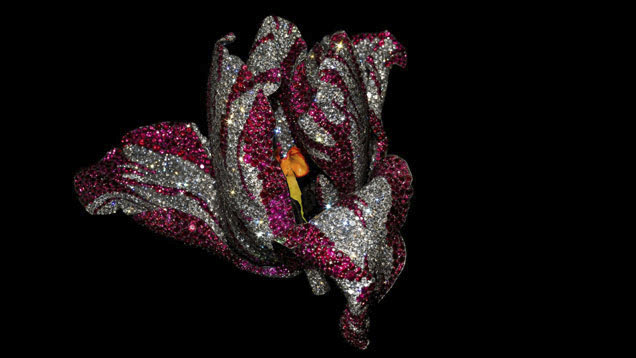
The assembly of this jewelry collection is a rare event in itself, because of the sheer exclusivity of JAR’s work. Visitors are able to enjoy an ensemble of realistic, life-sized, multicolor pieces. JAR favors a floral theme (figure 2), and over a hundred examples are on display. Animal motifs are much less represented, numbering just over fifty. The dominant gemstones are diamonds, sapphires, rubies, and pearls. Some rare gemstones, such as sphalerite and alexandrite, are also displayed. JAR also masterfully reuses micromosaics, antique cameos, 18th century miniatures, and materials such as beetle wings in his designs. Titanium mountings, which allow the display of unusual metal colors such as blue and violet, have made him an innovator in the industry.
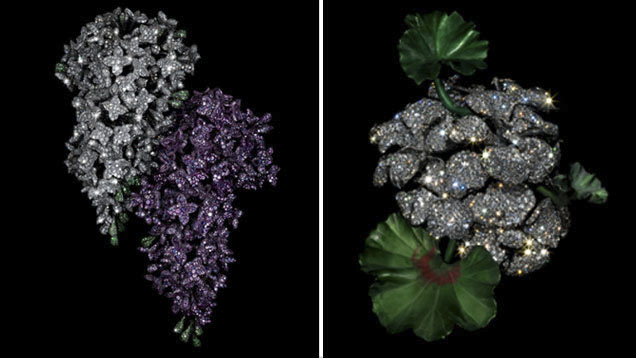
Figure 2. Left: From 2001, diamonds, lilac sapphires, garnets, aluminum, silver, and gold are assembled to form this lilac brooch. Right: JAR created this geranium brooch (2007) using diamonds, aluminum, silver, and gold. Both pieces are from private collections. Photos by Jozsef Tari, courtesy of JAR, Paris.
The exhibit and associated merchandising events have stirred some controversy, with accusations that the Met, a world-class cultural institution, is acting as a commercial space. The JAR retrospective has also been pinned as a glorification of an elite taste for expensive objects.Regardless, given the rarity of these pieces, this in itself makes this a remarkable event for the jewelry enthusiast. Gemologists will appreciate the superb quality of gemstones used by JAR in artful pavé-set creations. The splendor of rubies, diamonds, sapphires, and natural pearls in selected pieces is particularly striking (figure 3). The arresting quality of these objects makes up for the lack of mise-en-scène of the exhibit itself, which provides no signage other than a short biography of JAR. No organizing theme is established for the layout. While the connoisseur may be able to discern different themes, the general public is likely to be overwhelmed by the multiplicity of floral and animal pieces, as I witnessed during my visit. A simple booklet, featuring a succinct object list, is a welcome keepsake, though lacking jewelry dimensions and carat weight information. The scarcity of information is not solved by the exhibition catalogue, which only features 70 of the 395 pieces from this retrospective.
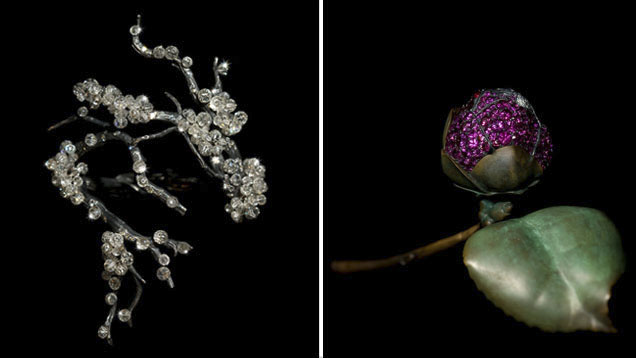
Figure 3. Left: This JAR bracelet featuring diamonds, silver, and platinum, was created in 2010. Right: The camellia brooch, also from 2010, uses rubies, pink sapphires, diamonds, silver, and gold in its design. Both pieces are from private collections. Photos by Jozsef Tari, courtesy of JAR, Paris.
The exhibition’s pathway is circular and runs clockwise in a long oval room. The first collection consists of fifty floral pieces, mostly brooches; the ruby and diamond parrot tulip brooch is particularly alluring. This group is followed by an ensemble of sixty pairs of earrings, designed in more abstract and decorative patterns (figure 4). The second wall presents an assembly of unusual objects such as abstract pieces, boxes, sculptures, watches, and clocks. The hyperrealism, originality, and precision of some of these works shows JAR’s wide-ranging inspirations. Certain pieces of this window display bring an unexpected element of surprise and humor in this solemn setting. The lettuce leaf and 18th-century micromosaic rabbit brooch (linked by a chain), along with the asparagus brooches, are worthy of notice.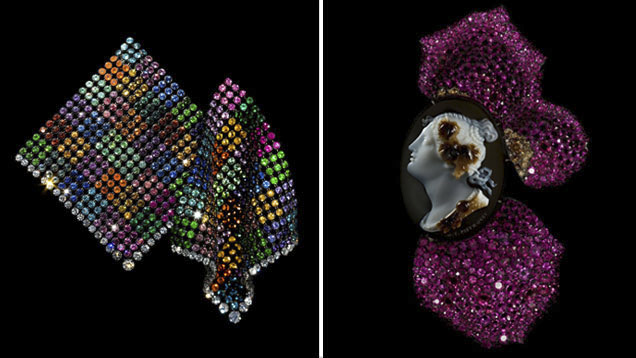
Figure 4. Left: JAR’s multicolored handkerchief earrings (2011) is an assemblage of sapphire, garnet, zircon, tourmaline, emerald, ruby, fire opal, spinel, beryl, diamond, platinum, silver, and gold. Right: This cameo and rose petal brooch, also from 2011, incorporates ruby, diamond, silver, and gold in its design. Both pieces are from private collections. Photos by Jozsef Tari, courtesy of JAR, Paris.
Visitors can also enjoy the objects set in 14 square-column window displays, with one or two pieces on each side. One of the most iconic jewels of this group is a zebra brooch comprised of agate, diamond, sapphire, silver, and gold (figure 5); a sheep’s head brooch, made of natural pearls, sapphire, and blackened silver and gold, is also intriguing. The exhibition continues with a rectangular window filled with 40 floral and vegetal pieces. The show concludes gracefully on a panel adorned with twenty butterfly brooches.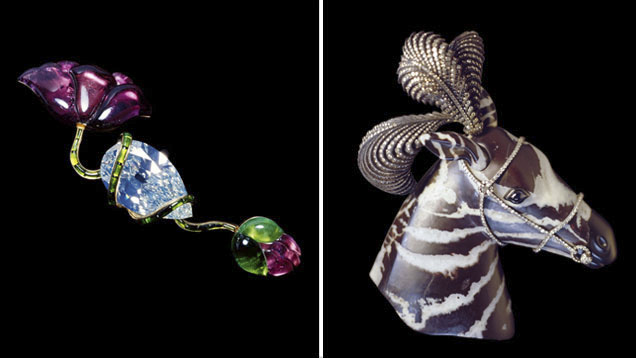
Figure 5. Left: This poppy brooch from JAR (1982) is comprised of diamonds, tourmalines and gold. Right: The iconic zebra brooch from 1987 is made from agate, diamonds, sapphire, silver, and gold. Both pieces are from private collections. Photos by Katharina Faerber, courtesy of JAR, Paris.
While the general public may note the lack of scenography and description and therefore miss his artistry and craftsmanship, “Jewels by JAR” is a must-see for the jewelry enthusiast who wishes to become more familiar with these rare and eclectic masterpieces.
ABOUT THE AUTHOR
Delphine Leblanc is a valuation specialist at Tiffany & Co. in New York City.
.jpg)


